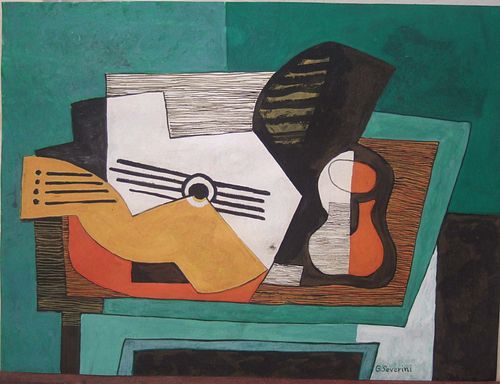Gino Severini. Cubist Still Life with Guitar, Gouache on Paper
About Auction
Mar 31, 2025 - Apr 20, 2025
Impressionist & Modernist Paintings & Drawings. Important early Modernists: Picasso, Lautrec, Leger, Degas, Jawlensky, Matisse, Cortez, Kandinsky, Klee, Thomas Hart Benton, Offers welcome. Also: Jewelry, Sculpture & Furniture King Art & Antiques kking15259@aol.com
- Lot Description
Gino Severini was born in Cortona, Italy on 7 April 1883 - Paris February 26, 1966. This gouache on paper is 26cm by 35.4cm ( 10.2" by 13.9" ), signed LR G. Severini. Title Cubist Composition Guitar on Table Condition Good Gino Severini, Italian, 1883-1966. Provenance: Purchased from F Regianni, Rome Anita Carmen Herrera-Lacoutoure, Paris Darius Talyarken Collection London, Purchased from Talyarken Estate circa 1990, Private UK Dealer Private Illinois Collection Collector's stamp verso: Darius Talyarken, London F Regianni, Rome, Anita Carmen Herrera-Lacoutoure, Paris In 1899 the Italian painter, graphic artist and sculptor went to Rome in 1899 to attend evening classes at the Villa Medici. After a decisive encounter with Giacomo Balla and Umberto Boccioni he began working as an artist in 1901. Balla introduced him to the divisionistic colour technique of the Neo-Impressionists*. Gino Severini moved to Paris in 1906 where he studied the Impressionists*, was fascinated with Seurat's paintings and met Signac. Beside Modigliani, Picasso, Braque and Gris he further encountered various well-known poets and thinkers of his time. Marinetti and Boccioni invited him to join the Futurist* movement. On 11 February 1910 Severini signed the 'Manifesto of Futurist Painting' and thus became a co-founder of this style. In contrast to his artist colleagues, Severini was barely interested in the dynamic of machines, but in the depiction of human bodies in motion. His cabaret scenes and depictions of dancers were made during his period. Works such as Blue Dancer (1912) show the typical Futurist principles of faceting and simultaneous effects. Severini exhibited works in 1912 at the Futurist exhibitions in Paris, London and Berlin and developed relationships between Italy and France. The artist's work became Cubist* after 1915. From now on the artist increasingly focused on the harmony of geometric constructions such as the golden section. His favourite subjects were the still lifes with musical instruments and scenes from the Commedia dell' Arte. Between 1924 and 1935 Severini was commissioned with numerous murals and mosaics. He led an exciting life between Rome and Paris and published theoretical texts and books on art. Severini was awarded the Grand Prize of the Venice Biennale* in 1950. The divisionist concept of the picture, together with a Cubist-Futurist style, which was adopted by Balla, is typical of Severini's entire oeuvre*. He analyzed light, movement and events, which happened after one another but are linked by memory. Gino Severini died in Paris on 26 February 1966. Important works by the artist are today exhibited in Milan (Collection Gianni Mattioli) and Rotterdam (Museum Boymans-van-Beuningen).
- Provenance
Provenance: Purchased from F Regianni, Rome Anita Carmen Herrera-Lacoutoure, Paris Darius Talyarken Collection London, Purchased from Talyarken Estate circa 1990, Private UK Dealer Private Midwestern Collection Collector's stamp verso: Darius Talyarken, London F Regianni, Rome, Anita Carmen Herrera-Lacoutoure, Paris
- Shipping Info
-
Shipping within the contingent USA is not included in the sales price except listed otherwise. Any overseas shipping will be negotiated between buyer and seller and paid by buyer. Shipping will be insured and shipping is on Monday & Tuesday to avoid over the weekend storage in transit warehouse
-



 EUR
EUR CAD
CAD AUD
AUD GBP
GBP MXN
MXN HKD
HKD CNY
CNY MYR
MYR SEK
SEK SGD
SGD CHF
CHF THB
THB







